The Blue-Tongued Skink is a lizard that you may find sunning itself on the sands of Australia and possibly even using its bright blue tongue to scare away predators. Native to the deserts of Australia, New Guinea, and Tasmania, these reptiles typically measure over 12″ long.
While well-known among reptile owners for their completely unique bright-blue tongue, the rest of their bodies don’t exactly match, as a brown or gray blend of colors.
They may be shy, enjoying hiding in the crevices of rocks and logs, but they can be very friendly if they are handled frequently.
These skinks are omnivorous and will eat many different fruits and vegetables, as well as insects, snails, and even smaller lizards. Because of their diet, they are relatively easy to feed.
A unique looking and docile pet, keep on reading to learn how to care for them.
What Is A Blue-Tongued Skink?
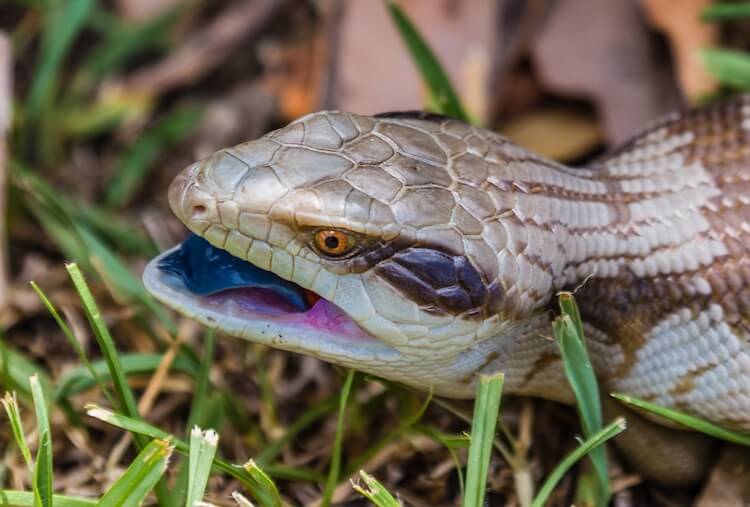
Scientifically known as the Tiliqua scincoides, this lizard is native to Australia, New Guinea, and Tasmania. They are mostly found in desert-like ecosystems, but can also be found in warm-forests and grasslands.
They are ground dwellers and like to burrow into log crevices and sand, or hide under brush to avoid predators.
The appearance of this pet is what gives them their name. They are long, sturdy, and stocky lizards that appear to be snakes with short and stubby legs. Perhaps the most striking feature of the Blue-Tongued Skinks is its distinct blue tongue.
This bright tongue is used to ward off predators when the skink is threatened, and is one of the reasons why reptile owners love them!
Blue-Tongued Skinks have a relatively normal diet. They rarely come out of their hiding spots to eat, instead they eat relatively infrequently and consume foods that are easily attainable, such as fruits and vegetables.
A trickier reptile to take care of, their natural environment will fluctuate between cool and very hot, whilst always remaining humid. It can sometimes be difficult to regulate this in captivity.
The Blue-Tongued Skink is very friendly if they are handled often. Otherwise they can become very scared, shy and resistant to being held by hiding when their cage is approached.
These skinks would rather live alone, males have been known to become aggressive with each other and even towards females.
| Lizard Quick Facts | |
|---|---|
| Common Names | Eastern Blue-Tongued Lizard, Northern Blue-Tongued Skink |
| Scientific Name | Tiliqua scincoides |
| Adult Size | 12-24 inches, up-to 500grams |
| Lifespan | 10-15 years |
| Diet | Insects, Smaller Reptiles, Fruits, Snails and Grubs |
| Tank Size | 40-60 gallons |
| Humidity & Temperature | 70-80°F and humidity should be kept between 40-60% |
| Popular Alternatives | Prehensile-Tailed Skink, Sandfish, Blotched Blue-Tongued Lizard |
Blue-tongued Skink Care Guide
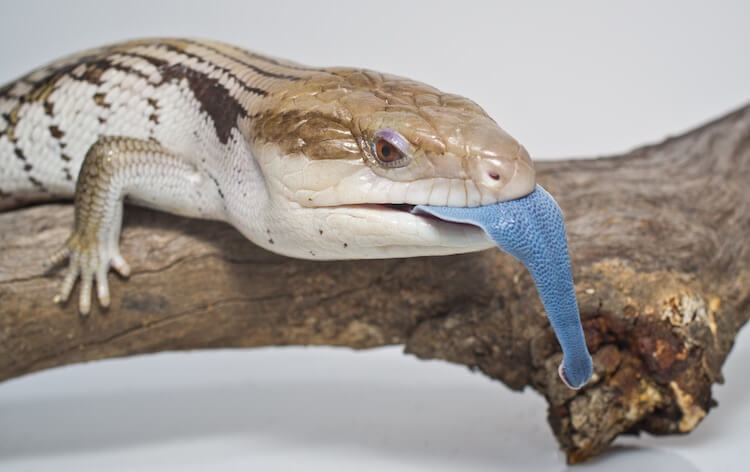
In the wild, this reptile will live in desert and shrub environments. They spend the majority of their time hiding in the sand or under logs.
The temperatures of Australia, New Guinea, and Tasmania are warm and humid so skinks need lots of hiding places to get away from the heat.
Tank and Enclosure
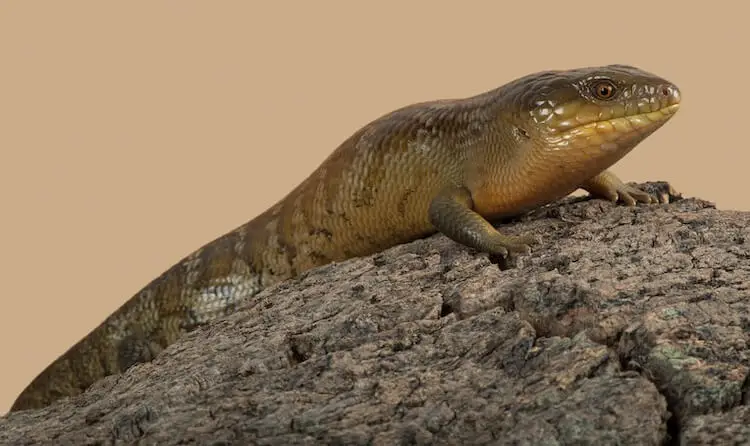
Your Skink will need lots of room in their enclosure. A glass tank, ideally one with lots of floor space, measuring 3 feet square is best as they like to spend time on the ground and do not climb as much as other lizards.
This tank should be a minimum of 40 gallons in size, but it can also be as large as 60 gallons provided the skink has everything to keep them comfortable.
The height of the tank should be chosen with the knowledge that it will need a hood to contain a heating element.
The best material for an enclosure is glass because heat can be easily transferred into and out of the tank.
You should try to include live plants, logs, and rocks (including a larger rock to bask on) in the tank as they do not usually stray far from their homes and need plenty of spaces to hide in.
Lighting
These skinks need a basking spot.
They need a heat lamp that can bring the tank up to a temperature between 95℉ and 100℉. This lamp does not need to be on constantly and should contain a 100 watt incandescent bulb.
Keeping the enclosure away from a window is essential because sunlight may cause it to heat up to 110℉ (which is too warm for this reptile).
If your skink spends all of its time in the shade or in the water bowl, then their enclosure is too hot.
Heating and Temperature
Because the temperature fluctuates in their natural habitat, there are multiple ranges of temperatures required:
- The general temperature of the tank should be kept between 70℉ and 80℉. This can be achieved if the room their tank is placed in is kept between these temperatures.
- A hot basking area is required and should be kept between 95℉ and 100℉.
Substrate
Due to their high humidity requirements, the substrate in this tank should be able to sustain live plants.
Rich-soils should be incorporated into the substrate which should be spot cleaned every other day to clear out fecal matter. The tank should be fully cleaned and cleared out monthly (more on this later).
| Tank Tips | |
|---|---|
| Tank Type | Glass |
| Lighting | 100 watt Incandescent bulb, not on consistently |
| Best Substrate | Sand or soil, rocks |
Feeding
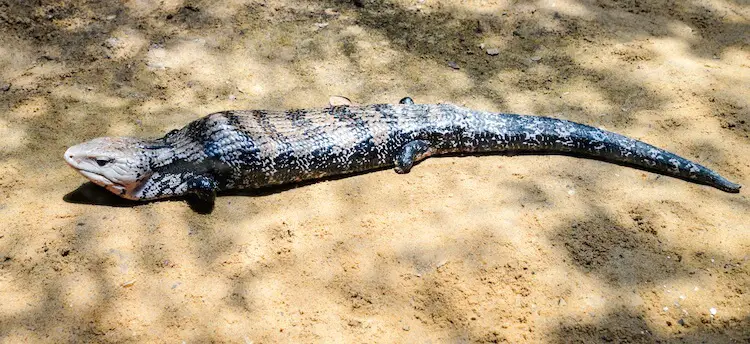
In the wild, the Blue-Tongued Skink is an omnivore. They use their tongues for hunting and sensing food, and once found, they’ll use their strong jaws to bite down on small lizards, insects, snails, grubs, flowers, and various fruits and vegetables.
Blue-Tongues rarely come out of hiding or stray far from their safe and cozy place to hunt. They are known to eat relatively infrequently and only during the daytime.
They must eat both live foods and plants.
Hatchlings will get their protein and energy from their egg. They absorb this yolk into their abdomens while developing, and this will sustain them for the first few days after birth. After this yolk is used up, hatchlings will hunt and forage for food on their own and eat an adult diet.
In captivity, Blue-Tongued Skinks may get their protein from pinky mice, crickets, mealworms, turkey, or chicken. Live food can include insects or even a baby mouse a few times a week.
Every other day, your skink should eat some fruits and vegetables, a couple slices of each. They will eat just about any fruit or vegetable, including collard greens and turnips.
They also require a D3 vitamin supplement (as they normally would acquire this vitamin by licking rocks in the wild). Some owners neglect this supplement, claiming they can get it from a high-quality diet, but we would recommend against this.
Food should be removed every two days to keep the tank clean and healthy. Water can be kept in a shallow bowl and should always be fresh.
| Diet Summary | |
|---|---|
| Insects | Crickets, pinky mice, chicken, turkey, mealworms a couple times a week |
| Fruits | A couple pieces everyday or every other day |
| Supplements Required | Vitamin D3 |
How To Keep Them Healthy
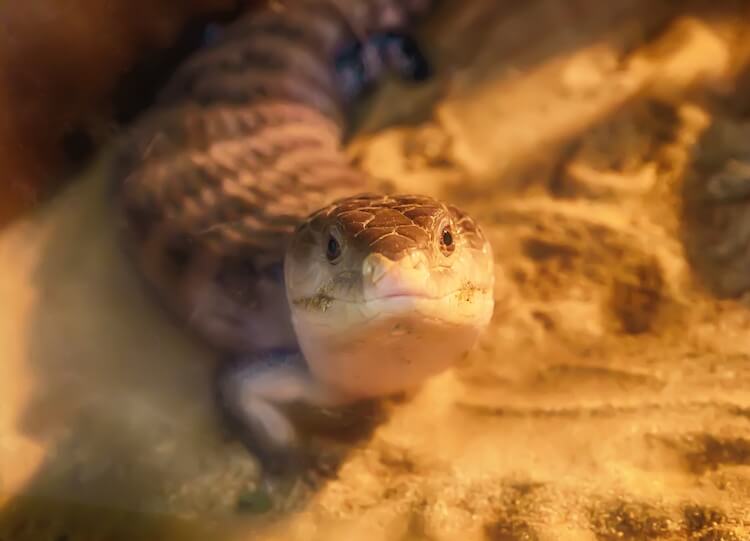
So that they are not scared by human contact, they should be handled frequently. Despite their bright Blue-Tongue they are not poisonous or venomous, but washing your hands before and after handling them will keep to keep them heathly.
Blue-Tongued Skinks do shed but they are able to do so with very little human interference. They will not need bathing during this time, but their skin should be cleaned out once it is fully shed.
Tank Cleaning
Their enclosure should be spot cleaned every other day to rid of old substrate, food and feces.
The tank should be deep-cleaned once a month and substrate should be fully replaced. If you skink is kept too dirty, it may lead to health issues (see below).
Feces should be relatively solid, elongated, and fully digested. If you lizard is having digestive issues, they may be passing undigested material.
| Signs They Are Healthy | Sickness Symptoms |
|---|---|
| Coming out occasionally during the day | Not coming out for days or weeks |
| Eating occasionally but regularly | Not eating |
| Moves slowly but without strain | Seemingly unable to move |
Blue-Tongued Skink Lifespan
In captivity a Blue-Tongued will livefor between 10-15 years if they are happy and healthy.
They are generally a hardy lizard and will be as healthy as their environment allows. Overfeeding may lead to obesity and a lack of calcium in their diet may lead to metabolic bone disease. A lack of cleanliness in the tank may lead to respiratory infections or mites.
Blue-Tongued Skink Behavior and Temperament
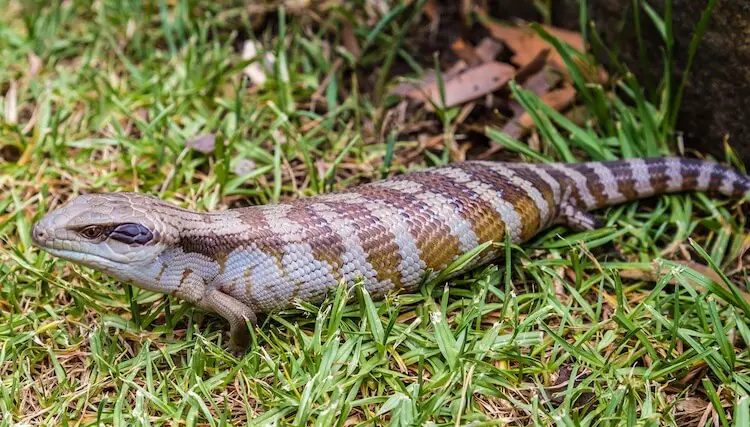
Blue-Tongued Skinks are diurnal, which means they are active during the day.
Naturally though, they are very shy; because of this, they are sensitive and do not stray far from their shelters. They use their claws to dig holes in the sand and to cling to rocks and logs.
If they are disturbed, they puff up their body, stick out their blue tongues, and hiss loudly to communicate their distress.
They display this behavior if they come into contact while searching for food too.
Like similar lizards, another ability which this skink has is the ability to lose their tails if they feel threatened. Other than this defensive behavior, they are relatively docile creatures.
Aggressive when it comes to mating, Blue-Tongued males are very aggressive towards each other if there are few females, and they may even be aggressive to the females while copulating.
This species of Skink isn’t nocturnal, however, they may still hide in logs or under rocks during the day. As they are not quick, hiding is their natural best defense against predators, and they will display similar behavior in captivity.
When it comes to handling, Blue-Tongued Skinks are relatively friendly, if they are handled often.
If they are not handled every few days, then they may become flighty and antisocial due to their natural instincts; they tame easily if started young, but they are not as out-going as some other lizards. Outgoing reptiles will be willing and may even like being held.
It is not a good idea to house several skinks together, especially if they are males. However, they should be fine in a room together if they live in separate tanks.
Appearance
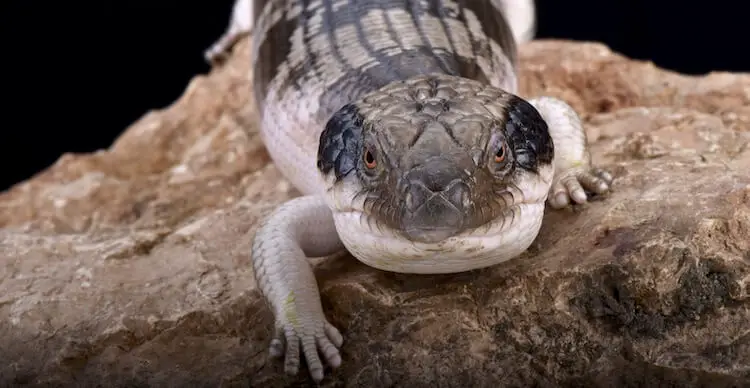
The scales on a Blue-Tongued Skink are smooth and shiny, they overlap each other similar to fish scales
These reptiles are a robust species and have long bodies with short legs. They also have long thick tails. Because of their short legs and long bodies, they waddle slightly when they walk.
There are no true differences in physical appearance between males and females.
Blue-Tongued Skink Size
Typically hatchlings are born around 4 inches in length weighing just half an ounce. They take a full three years to mature into an adult, by which time, they will measure more than 13 inches in length and over 450 grams in weight.
Colors
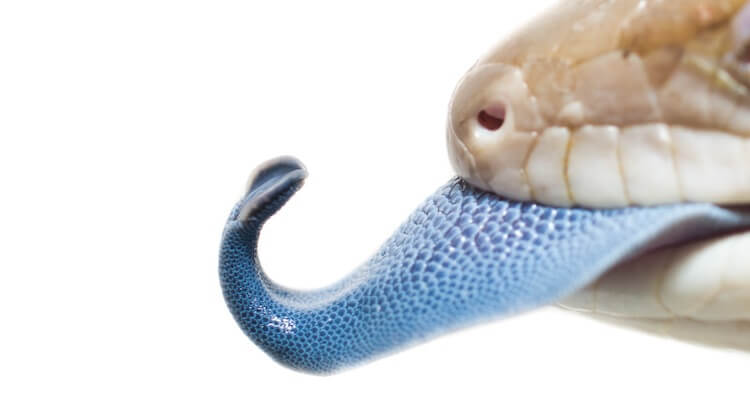
While the ventral (i.e. bottom) side of a Blue-Tongued Skink is usually light gray, the top side can include several dull colors such as:
- Brown
- Green
- Gray
Their blue-tongue is similar to ultraviolet-blue patches of skin on other lizard species.
Their tongue’s primary purpose is as a warning signal. Although not poisonous, it warns predators not to come closer and competitors to stay away from food.
How To Sex A Blue-Tongued Skink
Blue-Tongued Skinks do not hibernate, instead, they breed during the winter and spring months.
Males and females will crawl out of their hiding holes in the winter and spring to breed once a year. The males will trail the females until they allow copulation to occur.
They are ovoviviparous animals, which means that their eggs hatch inside their bodies! After conception, the mother will give birth to between 10 and 15 babies within 100 days. Because these skinks do not lay eggs, temperature does not affect the sex.
How Much Does A Blue-Tongued Skink Cost?
Australia prohibits the export of most wild animals, including lizards.
However, these skinks are commonly found from breeders and at local pet stores. A typical price is between $150-$250 USD, but rarer colors may cost as much as $1,500 USD.
Care Guide Summary
| Pros | Cons |
|---|---|
| Unique tongue color | Require specific basking lamp |
| Relatively easy to feed | Can be flighty if not handled correctly and frequently |
| Can be very friendly | Aggressive towards other skinks |
There are several species in the Scincidae family. The Blue-Tongued Skink is one of the most famous and is loved for its unique blue-tongued appearance, and very docile temperament (other skinks do not have this unique feature).
They may be docile and friendly, but they are not the most outgoing lizard and may be a pet for someone who is looking for more of a challenge. Teaching them to get used to humans may take some time and patience.
Their tank temperature needs to be regulated and monitored very closely. So this unique looking skink is one that can be welcomed to a home that is ready for a challenging reptile.
They will make great pets to those who are patient enough with them, and their bright tongues will make a unique addition to any home!

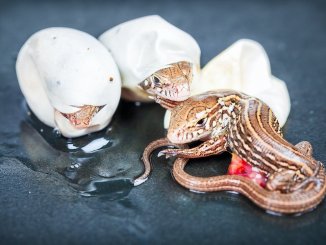
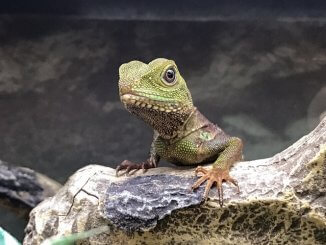
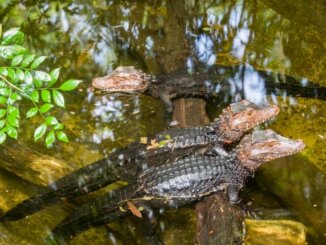
One of our 2 blue tongue skinks loves snails, crickets and banana but won,t eat any veg (apart from what has in the snail). How big a problem is this and how do I fix it?
Northern blue tongue.